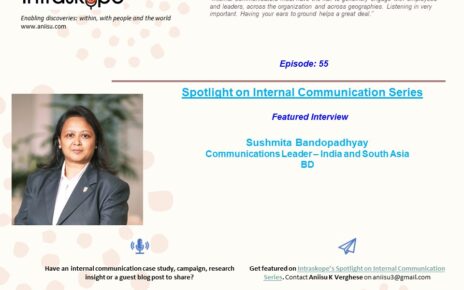Navigating a city is probably more complex than finding your way around an organization. Understanding your audience’s needs, focusing on the essentials, demonstrating empathy and sensitivity, making instructions simple and staying consistent are a few ways to make the communication experience fulfilling and meaningful.
Without naming the city and yet giving you enough color and context to frame my arguments let me attempt explaining how a well-managed city can teach us a thing or two about employee communications.
Communicating with its residents and visitors is akin to an organization engaging it staff and extended communities. You need to clarify what you stand for, what differentiates you and where the city is heading despite numerous economic and geo-political factors in play. How does one know if citizens are aware of their responsibilities and roles? By observing their motives and actions. For a tourist or a business traveler what one experiences through the numerous touch points and interactions with citizens shapes impressions about the city. When asked for help everyone, irrespective of what they do as a citizen (immigration officer, janitor, store clerk, transport customer care representative etc) is able to respond in exactly in the same manner – from providing simple directions to sharing recommendations for making the experience a success. Ensuring that documents are consistent, share similar messages and keeping it relevant in a way that every citizen can explain what the city does and represents. Reducing paperwork, keeping process steps minimal and yet finding ways to communicate important messages makes the ‘moments of truth’ matter.
Every employee, at any level or function, is essentially a brand ambassador. The employee needs to be aware of what the organization represents, appreciate it differentiators and serve as the face of the brand. Taking the time to brief and imbibe the values and culture of the organization will help employees positively articulate the brand personality. This can be achieved in multiple ways with the onus on leaders and communicators alike to help explain and reinforce what the brand stands for and how the values can be lived.
All experiences are opportunities to simplify and blend design with communication. From the seamless approach to clearing visitors through immigration, making all parts of the city accessible for differently abled people, creating a unified transport solution between rail networks, road lines and waterways, improving the visual representation of distances on maps to allowing people to make decisions based on accurate information – the simplicity and sensibility of the city gives one the impression that the leaders are thinking ahead. For example, right outside a popular food court a board informed potential customers that their estimated wait time would run about an hour giving people the option of choosing how they prefer to make the most of their time. On the subway train, a ‘progression’ graph indicates the stations the commute will cover and the estimated distance so that passengers can prepare for their journey better.

Internal communication blended with simple design can be a powerful differentiator. Understanding your audiences’ mindsets is useful to provide suitable solutions that matter. Knowing how and why your audiences prefer to access information is crucial to crafting direct communication. Be it a mobile app that allows employees to get to information on demand or a simple infographic that explains complex information in helpful ways or creating a walkthrough of a museum in such a way that visitors cover a majority of the exhibits in the shortest possible time; the power of design thinking can make internal communication effective.
Without investing in public infrastructure now and for the future and underestimating how the city will expand or grow it can be difficult to sustain services which benefit citizens. Knowing that tourism and trading are the mainstays of the city the administration reclaimed land and realigned critical elements that make the place efficient. A few examples include moving the airport to the outskirts reducing the risks of accidents and noise pollution, creating public spaces for citizens, adding audio channels for guided tours and investing in a theme park that will serve as a lasting testimony to the city’s creativity.
Likewise, investing in internal communication channel infrastructure for the future and improving adoption are fundamental to the functioning of an organization. These channels serve as a backbone and encourage two-way communication thereby improving reach, access and transparency. Modifying the channels to suit the evolving needs of your audiences indicates adaptability and agility.
You can gauge a city’s humane self by how it treats it citizens, tourists and business travelers. When safety of pedestrians is high on the agenda, traffic is orderly and regulated, escalators and travellators come with clearly labelled communication in multiple languages and periodic messages on safety and hygiene, differently abled people feel included through well-designed and accessible solutions on the streets and subways, pedestrian kerbsides are sloped to allow easy travel, WiFi is a given and priority seats in every form of transport are designated for the elderly, pregnant women, families with children and the disabled. Even with ongoing construction work around the city there is absolutely no noise or pollution which impacts commuters.
Sense and sensitivity in internal communication can improve trust and openness. When internal communication makes meaning of information and leaves little to chance audiences accept messages sooner and easily. Transparency in communication bridges gaps and leads to reduction in unwarranted channels of communication opening up – grapevine for example. Through consistent action and communication your audiences gain confidence in the organization and perceive it as respectful and responsible.
While you don’t see police patrolling the streets it doesn’t mean that the city is short staffed or not keeping an eye out for trouble. Investing in surveillance methods offsets the need for police staff to be on the roads manning traffic and fighting crime. Instead it opens up opportunities for the force to engage citizens and deliver real-time solutions when needed. By improving the design of how crowds move through theme parks and stations among other public places reduces the risks of infectious diseases spreading through touch and common areas. Guidelines are clearly articulated and so also punishments for breaking the law.
For internal communication having checks and balances is relevant for consistency and to build rigor into the process. Giving employees a sense of direction with simple approaches that reward and reinforce what it means to stay on brand and be effective as an ambassador. By creating systems that take care of periodic communication the communicator can devote attention to areas that need improvement and engagement. Seeking feedback often and being transparent about how inputs will be used can go a long way to gain confidence of employees.
Overall, what makes a city’s internal communication or an organization’s employee communication make sense is the ability to connect at a human level, trusting people to do the right thing after you have given them the right guidance and support, using insights to stay ahead of evolving expectations and acknowledging audiences as partners who can serve as effective communicators and committed ambassadors.
What do you think?

